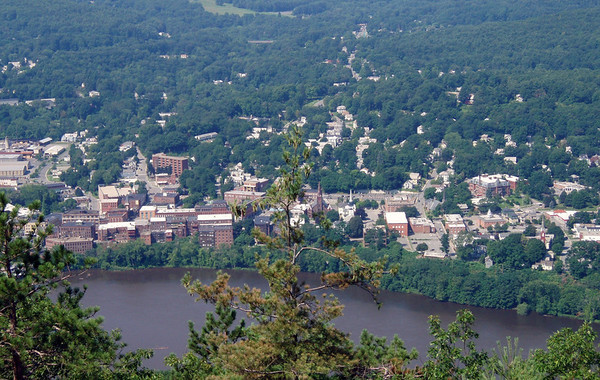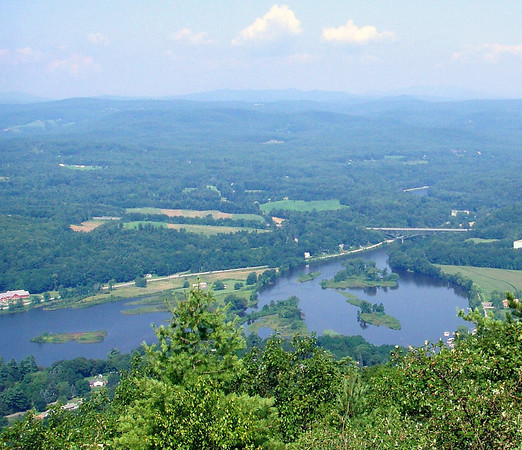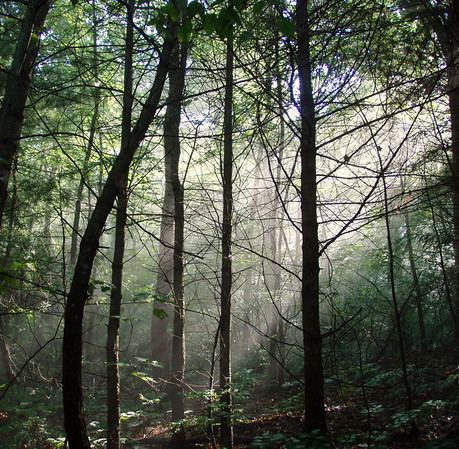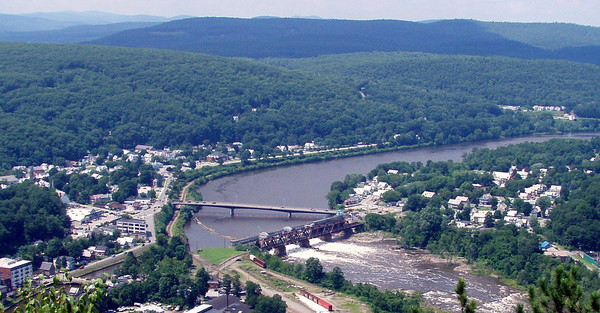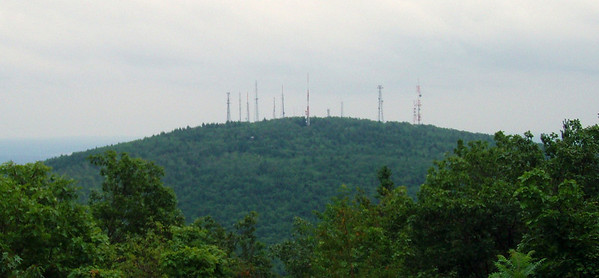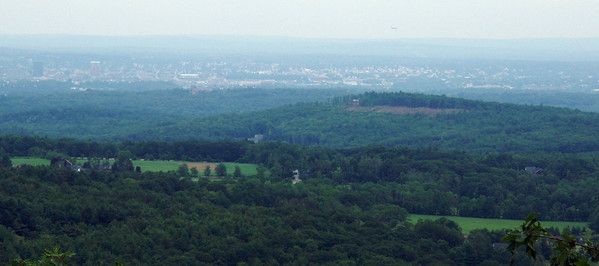Working the Thoreau 16 (Aug. 1 and 2, 2009)
Not to have hiked all the peaks on this List I compiled is a gap in my resume that I have determined to remedy. To that end, I hiked to four somewhat obscure summits in southern New Hampshire this past weekend. I enjoyed all four hikes in their own right, apart from connections to HDT.
Wantastiquet Mtn. On a visit to Bronson Alcott (Lousa May's father) in Walpole, NH in 1856, Thoreau stopped first in Brattleboro, VT for a few days. He climbed "Brattleboro's mountain," known to him as Chesterfield Mtn. but now called Wantastiquet. It rises fairly steeply on the New Hampshire side of the Connecticut River and a west-facing view ledge near its summit gave and still gives impressive views of Brattleboro below and the mountains of southern and central Vermont beyond.
The Trail leaves from the small parking lot for "Wantastiquet State Natural Area," reached in .2 mile by a dirt road that is your first left after you cross the bridge from downtown Brattleboro into Hinsdale, NH, just before a Wal-Mart. It winds in switchbacks for about two miles to the summit plateau, through attractive mixed woods.
Saturday morning, about half of the Trail was a stream and most of the rest was at least damp. A local I met on my way down who has been hiking there for years said it was the wettest he remembers. Still, I enjoyed both the hike and the views from the summit ledge, with its graffiti'd memorial to Walter H. Childs (whose memory seems otherwise lost even to Google). I took a herd-path east for about a quarter-mile to some ledges, ascending en route a knoll that may have been the north summit, but I gather from subsequent map-study that Mine Ledge must have been to my south.
Fall Mtn. Twenty miles up the Connecticut, this steep summit dominates Bellows Falls, VT much as Wantastiquet dominates Brattleboro. What may be the same forest road that Thoreau followed leaves from the end of Mountain View Road in No. Walpole, NH (hometown of Hall-of-Famer Pudge Fisk), a little north of downtown. It winds up steeply to the summit in about one mile, crossing near its beginning a utility right-of-way, immediately after which you take a right-hand turn (a small pond will be on your left immediately after that turn).
As you approach the summit, you reach a fork, and the left will take you to the summit ("Mt. Kilburn" on the topo map), which offers a pair of cell-phone towers and hardly any views. The right takes you under power lines and, in about .3 mile, to a pair of ledges with great views from SW to NW, including Bellows Falls below. This fork ends at the more southerly ledge, which falls off steeply and is known as Table Rock.
The Uncanoonucs. That is a Native American word that signifies "pair of perfectly rounded [summits]." which is just how they look on topo maps, especially older ones. They overlook Manchester, NH from its western suburb, Goffstown, and Thoreau wrote so little about his hike there with his brother in 1839, on their trip to the White Mountains, that it cannot be determined which one they climbed. Each has fine trails, however, so I visited both on Sunday, en route from central NH to eastern Mass.
The trail to No. Uncanoonuc, blazed with white tin discs, climbs fairly steeply up the north slope, through a handsome hemlock forest and passing a mossy cave, reaching the broad summit meadow in .6 mile. I have read of trash, but good people have been at work, as I found a big fire-ring but no litter. The only decent view, however, was of So. Uncanoonuc, festooned with a fright wig of communications towers.
Several trails leave the Goffstown public beach, on Uncanoonuc Lake, for the summit of So. Uncanoonuc, and elsewhere a paved road permits you to drive there. The beach area served as base for a major ski operation in the 1930s - called by one "the St. Moritz of America" - that the interested can learn about on this
http://www.nelsap.org/nh/uncanoonuc.html
I took the Incline Trail, which heads straight up to the summit road on the gravel bed of a sort of cog RR that operated for nearly 40 years, until sometime during WW II. While somewhat short on charm, it is direct. There were no very good views among the summit towers, nor at a clearing just off the Incline Tr. 100 yards below the summit marked by a "Viewing Area" sign. Another hundred yards or two down the Incline Tr., however, a side trail with the sign "Walker" heads west along the contour line for about .3 mile, before it turns right and starts heading down the mountain, due north. I think it must join the Summit Tr., which also goes up to the summit road from the beach area, but I didn't know about that then, so retraced my steps to the Incline.
Ten yards from its junction with the Incline Tr., an open ledge on the Walker Tr. gave me a terrific view east to Manchester and beyond - by far the best vista on either of the Uncanoonucs, as far as I could tell. I hope to head back there to explore those other trails and enjoy that outlook on a clear day, perhaps in Fall colors.
You can see the
rest of my pictures here.


